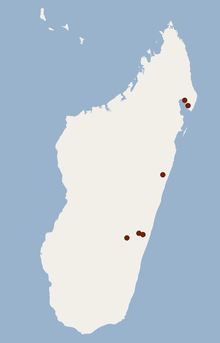Eger's long-fingered bat
Eger's long-fingered bat (Miniopterus egeri) is a species of long-fingered bat found in Madagascar.
| Eger's long-fingered bat | |
|---|---|
| Scientific classification | |
| Kingdom: | Animalia |
| Phylum: | Chordata |
| Class: | Mammalia |
| Order: | Chiroptera |
| Family: | Miniopteridae |
| Genus: | Miniopterus |
| Species: | M. egeri |
| Binomial name | |
| Miniopterus egeri Goodman, Ramasindrazana, Maminirina, Schoeman & Appleton, 2011 | |
 | |
Taxonomy
Eger's long-fingered bat was described as a new species in 2011 by Goodman et al. The eponym for the species name "egeri" is Judith Eger, Senior Curator of Royal Ontario Museum's Department of Mammalogy.[2]
Description
Eger's long-fingered bat is a relatively small member of its genus with a forearm length of 37–40 mm (1.5–1.6 in). Individuals weigh 4.2–7.6 g (0.15–0.27 oz). It has a dental formula of 2.1.2.33.1.3.3 for a total of 36 teeth.[2]
Range and habitat
Eger's long-fingered bat is endemic to Madagascar. It has been documented at a range of elevations, from 5–1,300 m (16–4,265 ft) above sea level.[1]
Conservation
As of 2017, it is evaluated as a least-concern species by the IUCN—its lowest conservation priority. It meets the criteria for this classification because it has been detected in many sites, some of which are protected areas. Additionally, it is not dependent upon forested habitat, and can presumably tolerate land use change such as deforestation.[1]
References
- Goodman, S. (2017). "Miniopterus egeri". The IUCN Red List of Threatened Species. 2017: e.T81633146A95642260. doi:10.2305/IUCN.UK.2017-2.RLTS.T81633146A95642260.en.
- Goodman, S. M.; Ramasindrazana, B.; Maminirina, C. P.; Schoeman, M. C.; Appleton, B. (2011). "Morphological, bioacoustical, and genetic variation in Miniopterus bats from eastern Madagascar, with the description of a new species". Zootaxa. 2880 (2880): 1–19. CiteSeerX 10.1.1.359.8725. doi:10.11646/zootaxa.2880.1.1.
